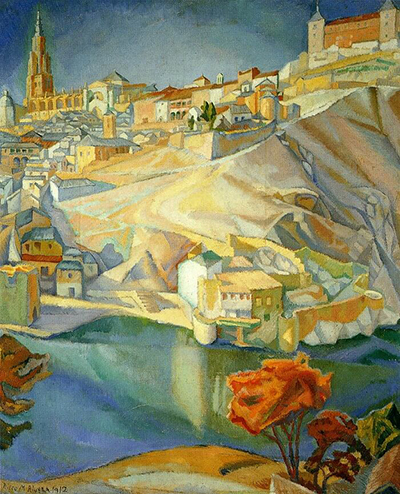View of Toledo is a stunning landscape painting by Diego Rivera which he completed in 1912. There are many references to masters from the past within the style and content of this work, making it far more than just an aesthetically pleasing piece.
First and foremost, the content is directly inspired by a painting of the same name by Greek master, El Greco. Rivera studied his work in great detail and loved the expressive manner in which he worked at that time. El Greco's View of Toledo came about in 1598-99 but still feels strangely contemporary all these years later. Both compositions feature a cityscape from a remote spot, and the artists choose relatively similar positions on the outskirts of the city. El Greco would excite us with a turbulent sky scene, where as in Rivera's version things feel a little calmer, with a river around the bottom of the painting which provides a balance against the sky at the top. He also delivers both in a fairly flat tone of blue which creates this relaxed atmosphere to the overall painting. The positivity continues in how light saturates the Mexican's version, with the roofs and walls of each building brightened up considerably, perhaps giving a direct indication of the typical style used in this part of the world.
Toledo itself is a stunning location, which benefits from a picturesque location which is combined by some historic and charming architecture. El Greco himself was from Greece but spent many years living in Spain which explains why so many of his more famous paintings now reside within the Prado Museum in Madrid. Whilst his version was enveloped in the El Greco style of expressive, dark and moody colours, Rivera almost presented us with the same location perhaps the morning after, once the clouds has lifted and the sun shone through. The cathedral at the top reaches up to the sky in a symbolic manner, looking down also on the other buildings which were situated on lower levels of the town. In the very foreground the artist sits upon a bank and reminds us of this with some flowers in the very foreground. Rivera also uses a relaxed approach to detail, far removed from the Realism artists of previous centuries and continues a connection to the work of Cezanne in the palette, with tones of light orange, pink and yellow.
Rivera would travel around Europe from time to time, in part to get away from political instability within his native Mexico and would find Spain the easiest place to reside because of the historical links with his homeland. He would study the works of El Greco and Francisco de Goya whilst living in Spain and considered these two to be amongst his favourite European painters, of all those that he came across. There is also a Cubist-esque approach in this painting in how the artist forms the various parts of the town and this is a direct link to the work of Cezanne as mentioned, who Rivera came across elsewhere during his time living abroad. Although the Frenchman did not work as a Cubist himself, he was regarded as the first true modern artist and many of his interpretations would lay the groundwork for other artists to develop and eventually arrive at the Cubist manner several decades later.




